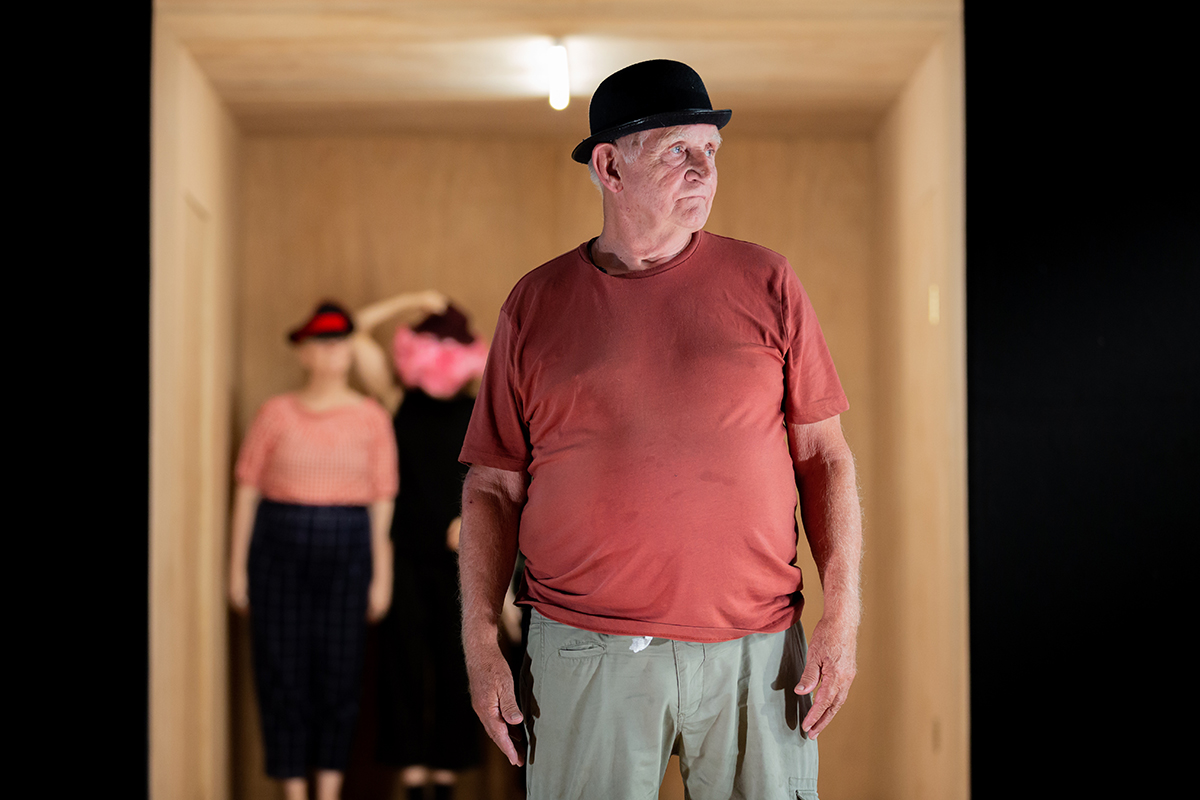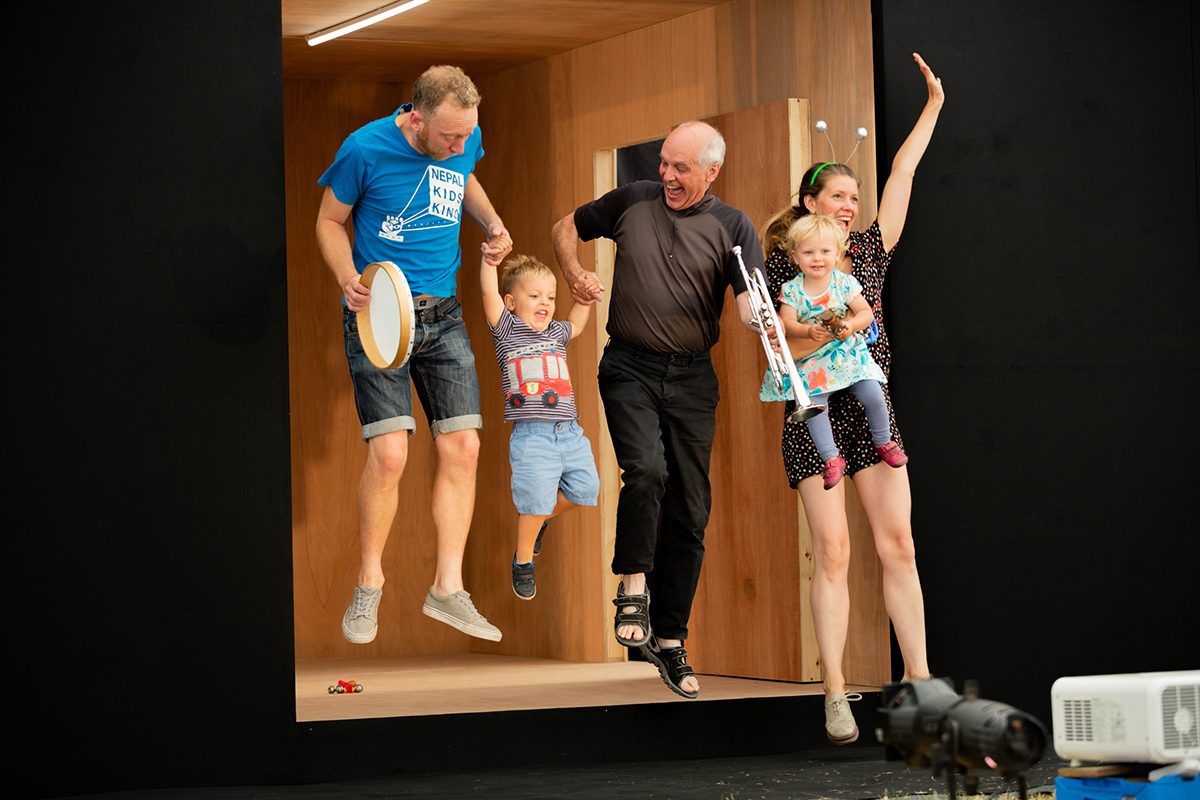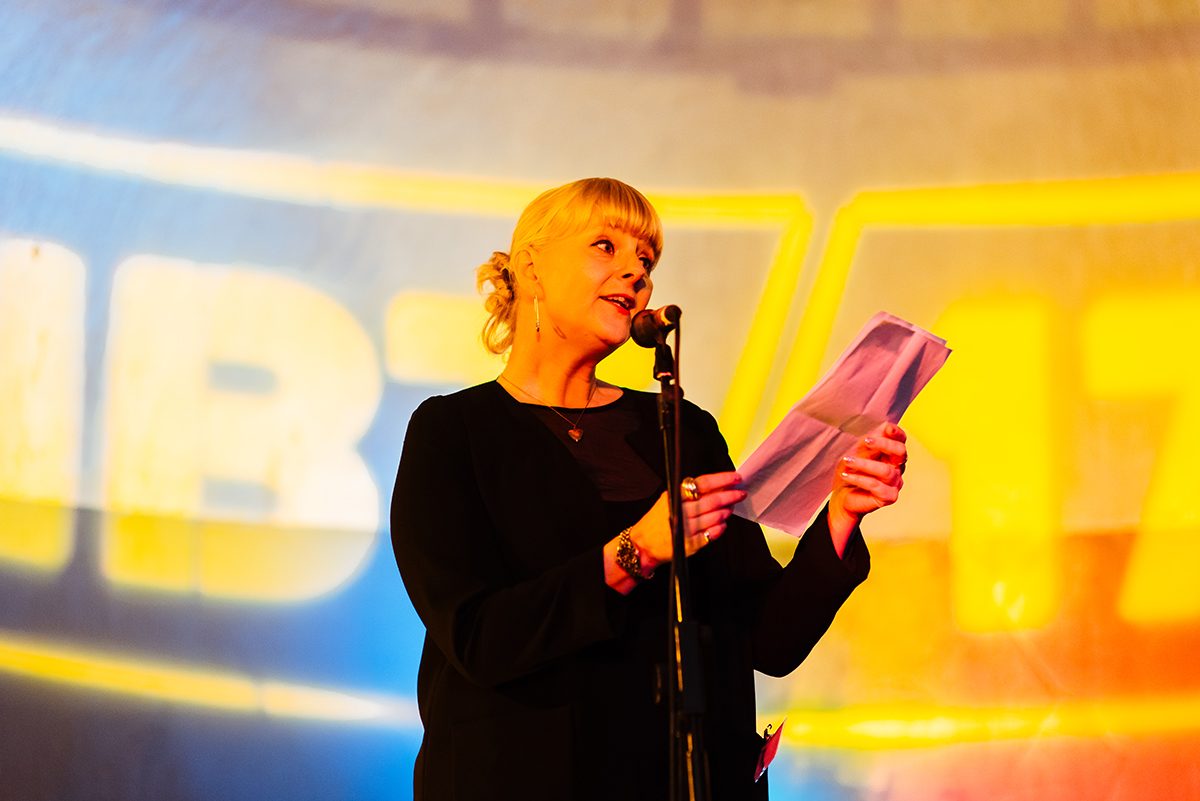
Back to Back, In Between Time & RealTime
“Occasionally (The Democratic Set) is like a dream sequence in a David Lynch film, disturbing, unstoppable. Sometimes it reeks of loneliness, people going about their business in some seriously fucked-up economy hotel. But mostly it’s full of laughter and hope, a feeling very much helped by the wide demographic of its contributors.” Timothy X Atack, RealTime, 2010
Eight years ago Back to Back Theatre made a Bristol version of The Democratic Set which had premiered in the 2009 Castlemaine State Festival in Victoria. Osunwunmi, who has been a regular contributor to RealTime since participating in a 2006 RealTime-In Between Time Festival review-writing workshop, was intrigued to see how the work had evolved in Back to Back Theatre’s return visit to her city. She spoke with the festival’s Artistic Director Helen Cole and Back to Back creator-performer Simon Laherty, artistic associate Tamara Searle and producer Alison Harvey at the making of a new Democratic Set at the Filwood Community Centre with the original 2010 Bristol performers.
Within the work’s frame individual Back to Back artists provide as prompts examples of what can be done, Simon explaining, “That’s what all of us do, like a small performance to show what we saw, sort of like to give the guys another go, show them what I can do; then they have their turn.”
This is what Osunwunmi witnessed as new episodes of The Democratic Set took shape.
Light fills the box, gorgeous and peachy with seaside colours: yellows, pinks and turquoise. A golden woman stands inside telling a risqué story. She’s not actually in a bikini though I remembered her so before checking the photos. She’s in jeans, and two shiny beach balls in the corner add luminous splashes of light.
A man is juggling. He and the director decide what lights to have on, whether to use purple or blue gels. Should there be a chair in the box? A projection? Someone throws single clubs into the frame at him from the wings — badum tish! It’s like he and the director are playing.
A pure-voiced youngster sings his own composition, meaningful rock-accented pop. Outside the box in shadow his mother shushes his baby sister.
An old clown — actually I think he was the Centre’s caretaker — has a whole 20-minute routine worked out but his collaborators haven’t turned up. Seventeen-second puppetry improvs follow, waspish, earnest, corny and hilarious. (“Let’s do another take.” “Are you sure? People have lives you know.”) Alison encourages him in the same innuendo-ridden music hall vernacular he uses himself. On the floor afterwards to be cleared away: the bowler hat, the pink wig and the flat cap, reminders of old variety in this community arts setting.
Behind the scenes a couple return to the Set eight years on, explaining that their no longer biddable sons, now teenagers, have better things to do this afternoon than collaborate with parental whimsy. The Fly Family are back! They have morphed into giraffes! They enter the box from opposite sides to negotiate a kiss, very much hampered by their heavy necks. The crew speculate whether puppeting, puppeteering or puppetry is the right word for these moments.
People come with punchlines that must be worked up to, with aphorisms that must be demonstrated, with crafted mini-dramas, with simple presentations: “Hello, I’m (Person) and I work at (Place) and I’d just like to tell you what we do, and we welcome everyone…” Some people come with just their name and where they live. A woman comes in with a bunch of golden shoes on her head. New people are always surprised that they’ve only got 17 seconds. Old hands from eight years ago find that their time has expanded.
The crew are smart, kind and super-efficient, expert at encouragement, at coaxing content out of small beginnings and at trimming content into crafted packages. They are also expert at knowing when not to push it, and I suspect in the final film some of the less shaped material may stand in its own truth, as compelling as anything. That is because I’ve seen the outcomes of this process before.
That last time I was struck by the edges of the performance frame, the places where light from the box leaked into non-performative space. The edges were like marginalia to the main event, discursive, full of possibility and of people waiting and geeing themselves up. Now the edges have been tidied up. The plywood performance box is guarded on all sides with a structure covered in blackout curtains. The Set is less accidental, eight years on. But what it is now, is stable, streamlined, mature and adaptable.
Boy Scouts came over after their meeting down the corridor to show off their routine: teaching the crew how to floss (that arm-swinging dance adults are incapable of.) Squeaky little, I mean irrepressible, young persons. I don’t know how the crew kept their energy up. Two people tried to keep their little dogs playing in the Set with a basket full of balls. Small plastic balls tipped slowly out of the box and rolled all over the hall, where the dogs followed. They were wary of the brightly lit space anyway, and there may be some footage of timid dog refusals at the edge of the frame. Or coaxing cries of “Come here boy!” from invisible sprites.
It was a long day: a bunch of artists turned up as it was growing dark and the crew would be working till past 10pm. They may have been sustained by cake, because there was cake in the kitchen (there were flowers in the garden, sun on the railings and hot air balloons sailing over the roof —we were having a heat wave) but all the packed lunches I saw were alarmingly, frugally, healthful. A description I’d been given of company members checks out. As Simon Laherty says, “When we go on tour, work hard, be on time, and don’t slack off, just keep going, just work, work, work, work, work.”
Talking about The Democratic Set: Helen Cole, Tamara Searle and Alison Harvey
HC Back to Back had originally been experimenting with film: what happens with using a simple frame, the same frame for everybody? What if you pass a lot of people through that frame and they all have the same democratic conditions: time — 17 seconds — and a box? I instantly thought, I really want to make something like that in Bristol. And I said, maybe we can look at whether it is tourable? Thirty shows later, it certainly is tourable! It’s worth considering that when they did it with us it was really the first time outside their Australian home base, whereas now they’ve done it in 30 different countries.
TS Our technology has gotten better. We’ve gotten fancier with the way that we run it. We’re always looking for different ideas to be in it so that’s always pushing us to explore what else it can be as a form. Since that first iteration now we light it and we project into it, we project behind it, we take the back off the box and we use the sides of the image rather than just the box so sometimes we shoot outside or around the sides of it. What’s changed, I guess, is that originally we were trying to make perhaps the perfect kind of frame. But now we’re just as interested in exploding the frame, as in what the frame can give us.
AH We also have taken it and worked with specific groups and remained with them for the whole three days rather than just having that 20-minute sweet spot with people. The difference there is that we get to explore, we get to break, explode the box a little bit more because we’ve got more time to play. So it becomes a different film but still very identifiable as the Dem Set.
It has an ever evolving and ever growing audience which is the beauty of the project and why it continues to expand in what it is and how it can work, and how it can reach its own community and its own audience. It actually inspires us to experiment with other models.
TS I tell you there’s quite a lot of formal facilitation here in terms of providing this quite strong offer. And beyond that it’s up to the person what they want to do. But the frame is quite strong. There are discussions about the Democratic Set, creating it as a model for giving it over to communities to do it for themselves rather than us having to be there to curate or produce it.
HC There’s something interesting for me about what it means to work with an artist or company from the other side of the world and have a 10-year relationship with them. There’s something about that company having a knowledge of this place because of the people they’ve met — and they’ve properly met them, they haven’t just done a show in front of 150 people and been there for two days and left. They’ve been in Bristol for two to three weeks each time. We ensure that we’ve got people for the project beforehand, some who wouldn’t normally come into an art space. It means the company is seeing a picture of Bristol that probably most of the artists we work with don’t have. It’s part of We Are Bristol, a three-year program to bring international artists into direct collaboration with people from the city, creating a community of people with international links — people who want to present a picture of Bristol that includes them.
Postscript: on RealTime
HC Of course there are more academic publications and then there’s the more populist culture-vulture kind of publications; but RealTime is something very specific. It’s also specific because it’s been part of a practice in one country that has lasted decades. So they’ve been the witness and the critical friend of an entire community of practice in Australia. That’s the thing I think is incredible: that longevity.
Also I think it’s really important in a country like Australia that that publication has existed. Coming at this as an outsider, what I can see is a country that’s massive. So the cultural communities congregate in the key cities like they do in all places, but those key cities are a long distance away from each other. Often artists don’t spend time with each other, they don’t see each other’s shows. Times are changing of course: social media, technology, have changed how we experience any kind of artistic experience, and any experience is mediated in different ways now. RealTime has been a part of that, of mediation of experience. Mediating the sense of value in a type of practice that often falls outside of mainstream media, they’ve done that brilliantly.
That’s looking in to Australia, but I’m very aware of what they’ve done for In Between Time, since that amazing workshop that we did in 2006. That was utterly them, their selection of writers, working with writers in an intense workshop situation and then retaining these relationships with people. When we did it I thought it would just boost some writing for that festival and be brilliant professional development for people from Bristol. But actually as a result of that deep connection between the writers and RealTime, they have covered every festival ever since, independently of In Between Time, completely.
Not only that but they’ve published my writing on occasion. What I know that has done for In Between Time is raised its profile massively in Australia. Now we have artists and producers — usually but not just professionals — coming to IBT, attracted to IBT because of that writing. And it’s not just In Between Time that has a high profile in Australia, I think there are significant artists from the UK who are known in Australia because of that relationship.
O At that first workshop Keith expressed very particular things he wants as an editor. One of them is precision, and one of them is vividness. Write about it so that a person who wasn’t there gets as good an impression of what it was like in a sensory way as you can possibly do. What did you think and feel as you were looking?
Since there’s such a bias towards academic writing, which can be incredibly dry, I always think it was a wonderful direction to have at the beginning of writing about art, and I’ve kept it to heart. Because art doesn’t work with words. It works beyond words when it’s proper, it’s a different thing. If you could just write an essay about it we wouldn’t need artists.
You don’t process art all at once, it stays with you. I think for that reason, describing an artwork conveys stuff beyond words that gives someone who wasn’t there, who then reads it, a chance to understand the work perhaps a little bit better.
Also I think there’s some realisation of the point of view of the practitioner by doing this. The question for a practitioner is How can I bring this out? A critical review asks, Do you want to go and see this show, or not? But what RealTime did was ask, What’s this show about, what do you think they were trying to get at? Did they make it? Did anything get in the way from the point of view of practice?
HC Sometimes the artists themselves don’t know the answers to all those questions and possibly having that writing about it helps them see it.
***********
In the room for The Democratic Set and making it work at Filwood Community Centre were all the people who came to make art and be visible including Dans Maree Sheehan, Rod Machlachlan and Sera Davies, and Tamara Searle, Alison Harvey and Simon Laherty from Back to Back Theatre, Helen Cole and Juliet Simpson from In Between Time, and Paul Blakemore, photographer.
–
We Are Bristol, In Between Time Festival: Back to Back Theatre, The Democratic Set, original concept, design, direction Bruce Gladwin, design, original set construction Mark Cuthbertson, original videography Rhian Hinkley
Previews of The Democratic Set video will take place at Trinity Centre, Easton on 4 October, and at Filwood Community Centre on 12 October. We Are Bristol is produced by In Between Time and developed in partnership with Knowle West Media Centre, Up Our Street, Ambition Lawrence Weston and UWE Bristol.
Top image credit: The Democratic Set, Back to Back Theatre, photo Paul Blakemore








